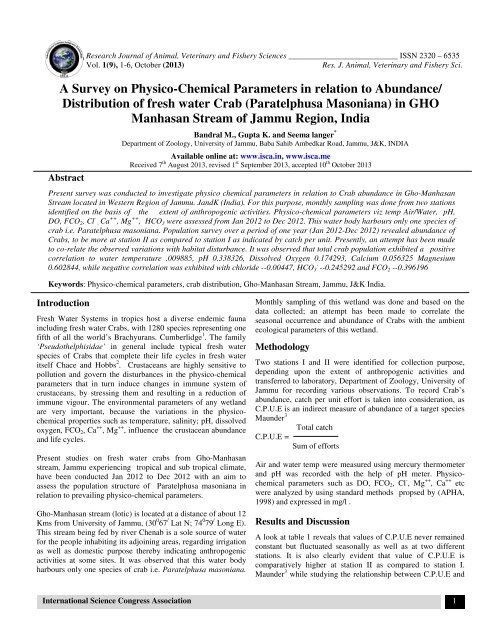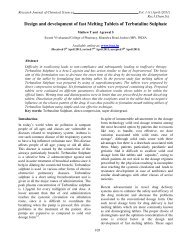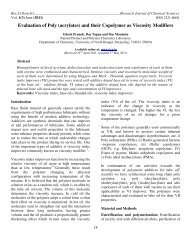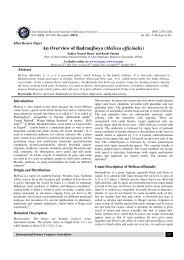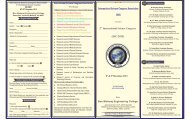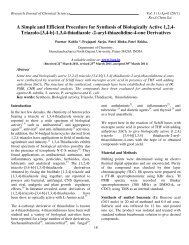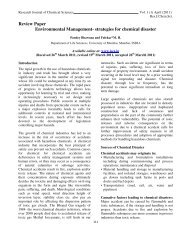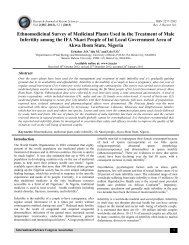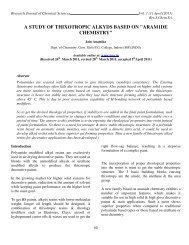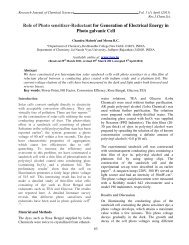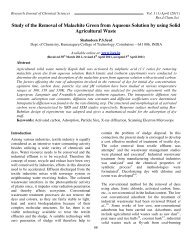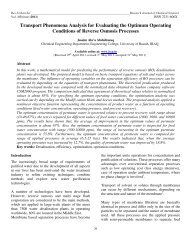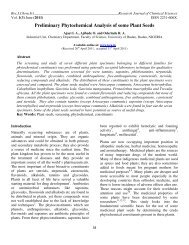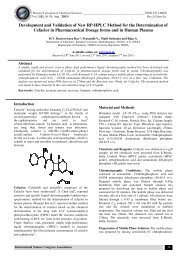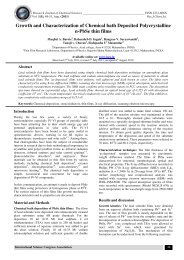Distribution of fresh water Crab - ISCA
Distribution of fresh water Crab - ISCA
Distribution of fresh water Crab - ISCA
You also want an ePaper? Increase the reach of your titles
YUMPU automatically turns print PDFs into web optimized ePapers that Google loves.
Research Journal <strong>of</strong> Animal, Veterinary and Fishery Sciences ___________________________ ISSN 2320 – 6535<br />
Vol. 1(9), 1-6, October (2013)<br />
Res. J. Animal, Veterinary and Fishery Sci.<br />
A Survey on Physico-Chemical Parameters in relation to Abundance/<br />
<strong>Distribution</strong> <strong>of</strong> <strong>fresh</strong> <strong>water</strong> <strong>Crab</strong> (Paratelphusa Masoniana) in GHO<br />
Manhasan Stream <strong>of</strong> Jammu Region, India<br />
Abstract<br />
Bandral M., Gupta K. and Seema langer *<br />
Department <strong>of</strong> Zoology, University <strong>of</strong> Jammu, Baba Sahib Ambedkar Road, Jammu, J&K, INDIA<br />
Available online at: www.isca.in, www.isca.me<br />
Received 7 th August 2013, revised 1 st September 2013, accepted 10 th October 2013<br />
Present survey was conducted to investigate physico chemical parameters in relation to <strong>Crab</strong> abundance in Gho-Manhasan<br />
Stream located in Western Region <strong>of</strong> Jammu. JandK (India). For this purpose, monthly sampling was done from two stations<br />
identified on the basis <strong>of</strong> the extent <strong>of</strong> anthropogenic activities. Physico-chemical parameters viz temp Air/Water, pH,<br />
DO, FCO 2 , Cl - , Ca ++ , Mg ++ , HCO 3 were assessed from Jan 2012 to Dec 2012. This <strong>water</strong> body harbours only one species <strong>of</strong><br />
crab i.e. Paratelphusa masoniana. Population survey over a period <strong>of</strong> one year (Jan 2012-Dec 2012) revealed abundance <strong>of</strong><br />
<strong>Crab</strong>s, to be more at station II as compared to station I as indicated by catch per unit. Presently, an attempt has been made<br />
to co-relate the observed variations with habitat disturbance. It was observed that total crab population exhibited a positive<br />
correlation to <strong>water</strong> temperature .009885, pH 0.338326, Dissolved Oxygen 0.174293, Calcium 0.056325 Magnesium<br />
0.602844, while negative correlation was exhibited with chloride --0.00447, HCO 3<br />
-<br />
--0.245292 and FCO 2 --0.396196<br />
Keywords: Physico-chemical parameters, crab distribution, Gho-Manhasan Stream, Jammu, J&K India.<br />
Introduction<br />
Fresh Water Systems in tropics host a diverse endemic fauna<br />
including <strong>fresh</strong> <strong>water</strong> <strong>Crab</strong>s, with 1280 species representing one<br />
fifth <strong>of</strong> all the world’s Brachyurans. Cumberlidge 1 . The family<br />
‘Pseudothelphisidae’ in general include typical <strong>fresh</strong> <strong>water</strong><br />
species <strong>of</strong> <strong>Crab</strong>s that complete their life cycles in <strong>fresh</strong> <strong>water</strong><br />
itself Chace and Hobbs 2 . Crustaceans are highly sensitive to<br />
pollution and govern the disturbances in the physico-chemical<br />
parameters that in turn induce changes in immune system <strong>of</strong><br />
crustaceans, by stressing them and resulting in a reduction <strong>of</strong><br />
immune vigour. The environmental parameters <strong>of</strong> any wetland<br />
are very important, because the variations in the physicochemical<br />
properties such as temperature, salinity; pH, dissolved<br />
oxygen, FCO 2 , Ca ++ , Mg ++ , influence the crustacean abundance<br />
and life cycles.<br />
Present studies on <strong>fresh</strong> <strong>water</strong> crabs from Gho-Manhasan<br />
stream, Jammu experiencing tropical and sub tropical climate,<br />
have been conducted Jan 2012 to Dec 2012 with an aim to<br />
assess the population structure <strong>of</strong> Paratelphusa masoniana in<br />
relation to prevailing physico-chemical parameters.<br />
Gho-Manhasan stream (lotic) is located at a distance <strong>of</strong> about 12<br />
Kms from University <strong>of</strong> Jammu, (30 0 67 / Lat N; 74 0 79 / Long E).<br />
This stream being fed by river Chenab is a sole source <strong>of</strong> <strong>water</strong><br />
for the people inhabiting its adjoining areas, regarding irrigation<br />
as well as domestic purpose thereby indicating anthropogenic<br />
activities at some sites. It was observed that this <strong>water</strong> body<br />
harbours only one species <strong>of</strong> crab i.e. Paratelphusa masoniana.<br />
Monthly sampling <strong>of</strong> this wetland was done and based on the<br />
data collected; an attempt has been made to correlate the<br />
seasonal occurrence and abundance <strong>of</strong> <strong>Crab</strong>s with the ambient<br />
ecological parameters <strong>of</strong> this wetland.<br />
Methodology<br />
Two stations I and II were identified for collection purpose,<br />
depending upon the extent <strong>of</strong> anthropogenic activities and<br />
transferred to laboratory, Department <strong>of</strong> Zoology, University <strong>of</strong><br />
Jammu for recording various observations. To record <strong>Crab</strong>’s<br />
abundance, catch per unit effort is taken into consideration, as<br />
C.P.U.E is an indirect measure <strong>of</strong> abundance <strong>of</strong> a target species<br />
Maunder 3<br />
Total catch<br />
C.P.U.E =<br />
Sum <strong>of</strong> efforts<br />
Air and <strong>water</strong> temp were measured using mercury thermometer<br />
and pH was recorded with the help <strong>of</strong> pH meter. Physicochemical<br />
parameters such as DO, FCO 2 , Cl - , Mg ++ , Ca ++ etc<br />
were analyzed by using standard methods propsed by (APHA,<br />
1998) and expressed in mg/l .<br />
Results and Discussion<br />
A look at table 1 reveals that values <strong>of</strong> C.P.U.E never remained<br />
constant but fluctuated seasonally as well as at two different<br />
stations. It is also clearly evident that value <strong>of</strong> C.P.U.E is<br />
comparatively higher at station II as compared to station I.<br />
Maunder 3 while studying the relationship between C.P.U.E and<br />
International Science Congress Association 1
Research Journal <strong>of</strong> Animal, Veterinary and Fishery Sciences ________________________________________ ISSN 2320 – 6535<br />
Vol. 1(9), 1-6, October (2013)<br />
Res. J. Animal, Veterinary and Fishery Sci.<br />
abundance <strong>of</strong> individual stocks held that C.P.U.E varies with<br />
(a) efficiency <strong>of</strong> a fleet (b) Species being targeted by a fleet and<br />
(c) environmental factors. Since there is only one type <strong>of</strong><br />
species <strong>of</strong> crab in stream (target species), therefore, both factors<br />
(a) and (b) are constant but environmental factors i.e. physicochemical<br />
parameters and anthropogenic disturbances (bathing<br />
by human and cattle in and around stream) varied to great extent<br />
at two stations seasonally.<br />
Table 2 and 3 represent the status <strong>of</strong> various physico-chemical<br />
parameters prevailing throughout the year Jan 2012-Dec 2012<br />
at station I and II.<br />
The crustaceans are highly sensitive to pollution and their<br />
distributions are strongly influenced by physico chemical<br />
parameters. The variations in physico chemical parameters<br />
influence crustacean’s abundance and life cycle.<br />
Temperature: Temperature is a limiting factor in aquatic<br />
environment and considerably affects various metabolic<br />
activities, growth, oxygen consumption, reproduction molting,<br />
survival, distribution and migratory behavior <strong>of</strong> crustaceans.<br />
The air and <strong>water</strong> temperature were found to go more or less<br />
hand in hand.<br />
During the study period Jan 2012 –Dec 2012 the air temperature<br />
at two stations fluctuated between 16 0 C to 40 0 C with maxima in<br />
June viz 40 0 C at both stations and minima in the month <strong>of</strong><br />
December. Like air temperature, <strong>water</strong> temperature varied<br />
between 12.5 0 C to 34 0 C at station I and 12 0 C to 33.5 0 C at<br />
station II table 2 and 3. In the present investigation, total crab<br />
population showed a direct positive correlation with <strong>water</strong><br />
temperature at both stations viz station I 003147 and station II<br />
009885 table 4. That the existing temperature range falls within<br />
the tolerable limits <strong>of</strong> crab is indicated by their respective CPUE<br />
values table-1 and such observations get authenticated by those<br />
made by Diwan and Nagabhushanab 4 who on the basis <strong>of</strong> their<br />
investigations on the heat tolerance in crab Barytelphusa<br />
cunicularis, concluded 34.5 ± 0.5 0 C to be the critical limiting<br />
temperature for the said species.<br />
Apart from survival, temperature also plays an important role in<br />
breeding. During study period, it was observed that juveniles<br />
started appearing in the collection during March-June there by<br />
indicating a rise in temp to be a stimulant for hatching. That the<br />
hatching bears a positive co-relation with increasing<br />
temperature further gets supported by the observation already<br />
made by Anger who while studying the effect <strong>of</strong> temperature on<br />
larval development <strong>of</strong> Chinese mitten <strong>Crab</strong>, Enocheir Sinesis,<br />
reported that development from hatching to metamorphosis<br />
occurred at a temperature more than 12 0 C. In this context the<br />
observations made by workers like Manohar and Qureshi 6<br />
became quite relevent who recorded a direct correlation between<br />
<strong>water</strong> temp and prawn ecological parameters 0.1111. Though<br />
very little variations in temperature are evident at the two study<br />
stations, yet the variations in population structure as indicated<br />
by C.P.U.E is remarkable. This can definitely be attributed to<br />
more anthropogenic activities at Station I as compared to<br />
Station II (table 2 and 3).<br />
pH: In decopods, pH influences the metabolism, physiology and<br />
maturation process. In the present investigation, pH value range<br />
between 6.7 to 7.1 at Station I and 7.0 to 7.4 at Station II which<br />
simply implies that <strong>water</strong> at Station II is slightly alkaline and<br />
more basic as compared to Station I (table 2 and 3). Very<br />
interestingly <strong>Crab</strong>s also followed the same trend <strong>of</strong> their<br />
population abundance viz station II > station I as indicated by<br />
C.P.U.E. Thus the relationship <strong>of</strong> pH to the crab abundance<br />
registered significant positive correlation viz +0.449495 at<br />
station-I and +0.338326 at station-II (table 4). Such findings are<br />
authenticated by work <strong>of</strong> Das and Sahoo 7 who held alkaline pH<br />
to be associated with more number <strong>of</strong> crab species up to a<br />
particular extent after which further increase in pH leads to a<br />
decrease in the number <strong>of</strong> species.<br />
Less crab pop at station –I can be attributed to slight acidic pH,<br />
which appears to be the main cause for decline <strong>of</strong> crabs at<br />
station I than at station II. This is in accordance to EPA 8 that<br />
accepted that the <strong>water</strong> quality criteria indicating pH range less<br />
than 6.5 is not suitable for aquatic species. Moreover, in this<br />
context a strong support can be drawn from the findings <strong>of</strong><br />
Sarah 9 , that pH have great effect on immunity <strong>of</strong> crabs, higher<br />
the pH more immune are crabs and a decrease in pH makes<br />
them vulnerable to infection. At lower pH 6.7 the activity <strong>of</strong><br />
phenol oxidase enzymes which helps to provide protection<br />
against infection in arthropod gets suppressed. This very clearly<br />
indicates that pH, like other parameters have marked influence<br />
on distribution /abundance <strong>of</strong> crabs.<br />
Depth: <strong>Crab</strong> abundance at station I shows negative co-relation<br />
viz -0.024061 with depth ranging from 14 to 42 cm whereas at<br />
staion II being less deep, a positive co-relation viz 0.0i5695 is<br />
observed with depth ranging from 18 to 30 cm (table 4). A<br />
similar relationship <strong>of</strong> depth with crab population has been<br />
highlighted by Marijnisson 10 who stated that crab density<br />
decrease with increase in depth <strong>of</strong> <strong>water</strong> body. Therefore,<br />
station I being deeper was characterized by less crab abundance<br />
as compared to station II which is less deep comparatively.<br />
Dissloved oxygen: During present course <strong>of</strong> study, the values <strong>of</strong><br />
DO at two Stations are highly variable, on the basis <strong>of</strong> which<br />
station I can be categorized as polluted one. At station I, (table<br />
2) dissolved oxygen fluctuate between 3.2 to 5.6 mg/ltr and for<br />
most <strong>of</strong> time i.e 10 months remained below 5.5 whereas at<br />
station II DO values fluctuate between 5.2 to 9.2 mg/ltr and for<br />
most <strong>of</strong> the period 11 months remained above 5.5. A very strong<br />
positive correlation <strong>of</strong> pH and crab abundance could be<br />
recorded viz + 0.095074 station I and +0.174293 station II.<br />
(table 4). Similar correlation have been established by Manohar<br />
and Qureshi 6 in prawn as well i .e +0.0778 Where as, Cheng 11<br />
while studying Haliotis diverscolor reported that haemolymph,<br />
osmolality and sodium balance at very low concentration at DO<br />
International Science Congress Association 2
Research Journal <strong>of</strong> Animal, Veterinary and Fishery Sciences ________________________________________ ISSN 2320 – 6535<br />
Vol. 1(9), 1-6, October (2013)<br />
Res. J. Animal, Veterinary and Fishery Sci.<br />
3.08 mg/land even lower than this value might result in acid<br />
base imbalance leading ultimately to acidosis for short term<br />
period and hence may then limit distribution <strong>of</strong> crabs.<br />
Station I with range <strong>of</strong> less DO than 6 mg/l shows polluted<br />
because <strong>of</strong> anthropogenic activities as compared to station II.<br />
This is supported by findings <strong>of</strong> Egemen and Sunlu 12 according<br />
to which the minimum. DO may not be < 5.0mg/l for aquatic<br />
life in <strong>fresh</strong> <strong>water</strong> ecosystem.<br />
This is also supported by CPCB 13 that <strong>water</strong> bodies with DO at<br />
6 mg/l or high is categorized as class I and less than 6mg/l is<br />
categorized as low class or polluted.<br />
FCO 2 : FCO 2 usually maintains an inverse relationship with pH,<br />
but a direct one with that <strong>of</strong> temp. In the present study the tables<br />
at two stations reflect that FCO 2 has been observed to fluctuate<br />
between 4.0-12mg/l at Station I and 4.2-7.4 mg/l at Station II<br />
(table 2 and 3). FCO 2 is negatively correlated viz -0.396196 at<br />
station I and positively correlated at station II viz +0.13258<br />
(table 4) therefore have strong influence on the crab population.<br />
At station I FCO 2 value was high during summers at high<br />
temperature (May-June) hovering between 10.0-12.0 mg/l but<br />
was inversely related to pH value range (6.8-6.9). Since FC0 2<br />
has great bearing on pH, therefore it can have strong influence<br />
on the <strong>Crab</strong> population. CO2 related increase in pH at station I<br />
may be responsible for resultant decline in <strong>Crab</strong> population as a<br />
consequence <strong>of</strong> disturbance in the acid base balance <strong>of</strong><br />
ecosystem. This can be authenticated by findings <strong>of</strong> spicer etal 14<br />
who also stated that CO 2 related acidification leads to<br />
disturbance <strong>of</strong> acid base balance in velvet swimming <strong>Crab</strong><br />
Neuora puber.<br />
Further, at station I anthropogenic activities add to the rate <strong>of</strong><br />
decomposition and respiration thereby increasing CO 2<br />
concentration in <strong>water</strong> body which further led to decline in crab<br />
population at this station. At station II positive correlation <strong>of</strong><br />
FCO 2 with crab abundance can be attributed to low values <strong>of</strong><br />
FCO 2 during summers (6.2-7.4 mg/l) and more basic values <strong>of</strong><br />
pH (7.1 and 7.2) as compared to station I showing negative<br />
correlation (table 2 and 3)<br />
Further no-anthropogenic activities were witnessed at station II.<br />
This comparison strongly indicates role <strong>of</strong> FCO 2 in crab<br />
distributions which is much pronounced at station II as<br />
compared to station I.<br />
Chloride: At Station I the levels <strong>of</strong> Cl - ranged from 23.6 to<br />
51.9 mg/l showing negative correlation with crab distribution<br />
and at station II, levels <strong>of</strong> Cl - (20-40mg/l) (table 2 and 3)<br />
though less than Station I but still indicate negative co-relation,<br />
with respect to crab distribution. It therefore indicated that<br />
increase in salinity at station I resulted in a decrease in crab<br />
population as compared to station-II where the levels <strong>of</strong> chloride<br />
are less than station I. Since chlorides helps in maintenance <strong>of</strong><br />
body fluid and acid base balance, therefore an increase in<br />
salinity <strong>of</strong> <strong>water</strong> influenced the acid base balance and hence<br />
checked distribution <strong>of</strong> crabs in study area. Whitely etal 15 too<br />
held that increase in salinity disturbs acid base balance and<br />
rather cause acidosis in crab and thus support the view that conc<br />
<strong>of</strong> Cl - does influence the distribution <strong>of</strong> crabs. Thus crab<br />
population <strong>of</strong> present investigation exhibited negative<br />
correlation with chloride viz -0.02784 at station I and -0.00447<br />
at station II (table 4). Manohar and Qureshi 6 also reported<br />
similar relationship with prawn population and chloride -0.0598.<br />
It was also noticed during present study that high values <strong>of</strong><br />
chloride content at station I is also related with anthropogenic<br />
activities which in turn can be attributed to less crab population<br />
at this station I. This is authenticated by findings <strong>of</strong> Khare etal 16<br />
according to which Cl - is important indicator <strong>of</strong> pollution. On<br />
the other hand absence <strong>of</strong> anthropogenic activities along with<br />
low level <strong>of</strong> Cl - at Station II indicated more congenial habitat for<br />
<strong>fresh</strong> <strong>water</strong> crabs.<br />
Calcium and Magnesium: Calcium and Magnesium are very<br />
vital components as far as crabs are concerned because they<br />
have their special requirement for these ions during the<br />
formation <strong>of</strong> exoskeleton.<br />
Though in comparison to Ca ++ , Mg ++ is required in very small<br />
concentrations. Mg ++ fluctuated between (40.2 -64.7 mg/l) at<br />
station –I and between 34.5 -54.9 mg/l at Station –II showing a<br />
positive correlation with crab abundance at two stations viz<br />
+0.495669 at station I and + 0.602844 at station –II. Table 2, 3<br />
and 4.<br />
Comparative high levels <strong>of</strong> Ca 2+ at station II (20.0 to 54.5 mg/l)<br />
as compared to station I (22.8 - 42.2 mg/l) show positive<br />
correlation viz 0.056325 with respect to crab abundance at this<br />
station but station I indicated negative correlation -0.326441<br />
(table 4). Present observation get strengthened by the findings<br />
<strong>of</strong> Neufeldt etal 17 who while studying effect <strong>of</strong> Ca 2+<br />
concentration in <strong>water</strong> on post moult uptake in blue crab.<br />
Callinectes sapidus, inferred that rate <strong>of</strong> Ca 2+ uptake in these<br />
crabs have direct relation with availability <strong>of</strong> Ca 2+ in <strong>water</strong> body<br />
as they require high concentration <strong>of</strong> calcium <strong>of</strong> surrounding<br />
<strong>water</strong> during ecdysis. At station I negative correlation appears to<br />
be an indicator <strong>of</strong> the fact that extremely low calcium possibly<br />
must have led to incomplete calcification <strong>of</strong> developing crabs.<br />
It was also observed that crabs having poor exoskeleton, being<br />
highly vulnerable to predation and cannibalism must have<br />
resulted in limiting their distribution at station–I. In this context,<br />
finding <strong>of</strong> Rayhanen 18 that in crustaceans, incomplete<br />
calcification lead to prolonged period <strong>of</strong> s<strong>of</strong>t exoskeleton,<br />
making them more valunerable to predation, very strongly<br />
justifies the less crab abundance at station –I.<br />
In comparison to station I, station II with high value <strong>of</strong> Ca 2+ and<br />
positive correlation with more abundance <strong>of</strong> crab population <strong>of</strong><br />
Juveniles and adults strongly indicates that calcium may limit<br />
International Science Congress Association 3
Research Journal <strong>of</strong> Animal, Veterinary and Fishery Sciences ________________________________________ ISSN 2320 – 6535<br />
Vol. 1(9), 1-6, October (2013)<br />
Res. J. Animal, Veterinary and Fishery Sci.<br />
the distribution and success <strong>of</strong> crustaceans in s<strong>of</strong>t <strong>water</strong><br />
localities.<br />
Carbonates and Bicarbonates: In <strong>water</strong> CO 2 exist in 3<br />
different forms viz FCO 2 , bound CO 3<br />
2-<br />
and half bound form<br />
(HCO 3- ). During present studies bicarbonates have been<br />
observed to be present at two stations but (CO 3 2 ) could not be<br />
ever recorded at any station as FCO 2 was present.<br />
Role <strong>of</strong> bicarbonates as buffer in a <strong>water</strong> body is <strong>of</strong> utmost<br />
significance particularly when it appears that bicarbonates by<br />
regulating pH in turn control the crab population abundance and<br />
same may be true for presently studied stream as well.<br />
At station I value <strong>of</strong> HCO 3 ranged between 430.3-886.3 mg/l<br />
with positive correlation +0.183321 whereas station –II 400.2-<br />
752. 0 mg/l showed negative correlation with bicarbonates -<br />
0.24529 thereby indicating s<strong>of</strong>t <strong>water</strong> at station II to be more<br />
productive than hard <strong>water</strong> at station I (table 2, 3 and 4). It was<br />
observed that at both the stations the level <strong>of</strong> HCO 3 was on<br />
higher side during summer and monsoon period. Present<br />
observations are in line with those made by Zuber 19 regarding<br />
increase in the value <strong>of</strong> bicarbonates in summer seasons.<br />
Verma 20 too emphasized maximum value <strong>of</strong> bicarbonates during<br />
monsoon because <strong>of</strong> entry <strong>of</strong> rain <strong>water</strong>, rich in CaCO 3 which<br />
increased the bicarbonates concentration in study area.<br />
Conclusion<br />
Based on the results <strong>of</strong> crab population vis-à-vis physicochemical<br />
parameters at two stations <strong>of</strong> Gho-Manhasan stream<br />
<strong>of</strong> Jammu Region, J&K it is concluded that <strong>water</strong> temp, depth,<br />
pH, FCO 2 , DO, Ca 2+ and Mg 2+ exhibit positive impact on crab<br />
abundance and therefore high C.P.U.E at station II can be<br />
attributed to the combined effect <strong>of</strong> (a) favorable <strong>water</strong> quality<br />
parameters (b) physical anthropogenic disturbances that are<br />
apparently very less at station II.<br />
Physical disturbances seemingly appear to have resulted in large<br />
scale changes in <strong>water</strong> parameters which ultimately influence<br />
crab abundance as is witnessed by a comparative low C.P.U.E at<br />
Station I.<br />
Table-1<br />
Catch per unit effort <strong>of</strong> <strong>Crab</strong> Paratelphusa masoniana<br />
during the study period (Jan 2012-Dec 2012)<br />
Months<br />
Catch per unit effort<br />
S.No<br />
Station - I Station – II<br />
1 Jan 2012 2.0 3.0<br />
2 Feb 2.6 3.3<br />
3 March 2.6 4.0<br />
4 April 3.0 4.3<br />
5 May 2.3 4.0<br />
6 June 3.3 5.0<br />
7 July 3.6 4.0<br />
8 August 3.3 5.3<br />
9 September 4.0 5.0<br />
10 Oct 3.3 6.0<br />
11 Nov 4.0 6.0<br />
12 Dec 2012 4.6 6.6<br />
Table-2<br />
Physico –chemical parameters at Station – I (Jan 2012-Dec2012)<br />
Month<br />
Temp 0 C Depth<br />
FCo<br />
pH<br />
2 DO Cl - Ca 2+ HC0- 3 Mg 2+<br />
Air Water (Cm)<br />
(mg/l) (mg/l) (mg/l) (mg/l) (mg/l) (mg/l)<br />
Jan -12 18 15.5 16 7.0 6.0 5.6 39.8 24.2 682.2 58.6<br />
Feb 20 19.5 30 6.8 8.0 5.6 36.3 28.4 860.2 40.2<br />
March 24 20 28 7.1 10.0 5.2 30.5 42.2 816.3 44.1<br />
April 28 24 32 7.2 8.0 4.8 30 26.3 512.3 53.4<br />
May 35 25 31 6.8 10.0 3.2 33.7 31.2 430.3 48.6<br />
June 40 34 35 6.9 12.0 3.2 45.9 41.6 722.2 50.5<br />
July 33 32 22 6.9 10.0 5.2 50.3 25.6 680.4 51.3<br />
August 37 28 26 7.0 8.0 4.8 51.9 26.2 650.2 40.8<br />
Sept 31 25 27 7.0 7.0 5.2 48.6 22.8 886.3 52.6<br />
Oct 29 23 25 7.0 6.0 4.8 40.7 24.0 683.3 55.4<br />
Nov 23 19.5 42 7.1 6.0 4.8 29.9 27.6 570.2 64.2<br />
Dec-12 16 12.5 14 7.2 4.0 5.2 23.6 23.2 726.2 64.7<br />
International Science Congress Association 4
Research Journal <strong>of</strong> Animal, Veterinary and Fishery Sciences ________________________________________ ISSN 2320 – 6535<br />
Vol. 1(9), 1-6, October (2013)<br />
Res. J. Animal, Veterinary and Fishery Sci.<br />
Table-3<br />
Physico-chemical parameters at Station – II along Gho-Manhasan Stream (Jan 2012 –Dec 2012)<br />
Month<br />
Temp 0 C Depth<br />
FCo<br />
pH<br />
2 DO Cl - Ca 2+ HC0- 3 Mg 2+<br />
Air Water (Cm)<br />
(mg/l) (mg/l) (mg/l) (mg/l) (mg/l) (mg/l)<br />
Jan -12 16.5 13 27 7.0 4.4 8.2 36.7 43.5 400.2 37.5<br />
Feb-12 20.5 18.5 19 7.1 5.6 7.2 18.9 14.0 764.4 39.6<br />
March-12 23.5 20 20 7.2 5.8 6.2 19.9 19.5 752 35.0<br />
April -12 27 23 22 7.4 4.4 5.4 17 24.5 496.2 49.6<br />
May 34.5 24 21 7.2 6.2 5.2 36 32.2 500.2 38.9<br />
June 40 33.5 23 7.1 7.4 5.4 36 27.7 685.4 46.7<br />
July 33 30 25 7.3 5.2 5.6 38 42.2 680.0 34.5<br />
August 37 28 28 7.2 5.8 5.6 40 54.5 535.1 47.2<br />
Sept 31.5 26 30 7.1 5.2 5.4 35 20.0 600.5 44.5<br />
Oct 30 24 27 7.2 7.2 6.2 33 12.8 484.2 42.5<br />
Nov 24 18 22 7.1 5.2 7.2 29 14.2 508.4 38.9<br />
Dec 16 12 18 7.4 4.2 9.2 20 52.9 530.0 54.9<br />
Table-4<br />
Co-relation values between crab Abundance and Physico-chemical parameters at two stations I and II during study period<br />
(Jan 2012-Dec 2012)<br />
S.No<br />
<strong>Crab</strong> Abundance (CA) /<br />
Physico-chemical parameters<br />
Station - I<br />
Station-II<br />
1 CA/Temp 0.003147 0.009885<br />
2 CA/Depth -0.024061 0.015695<br />
3 CA/pH 0.449495 0.338326<br />
4 CA/FCo 2 -0.396196 0.13258<br />
5 CA/DO 0.095074 0.174293<br />
6 CA/Cl - -0.02784 -0.00447<br />
7 CA/Ca ++ -0.326441 0.056325<br />
8<br />
-<br />
CA/HCO 3 0.183321 -0.245292<br />
9 CA/Mg ++ 0.495669 0.602844<br />
References<br />
1. Cumberlidge N. and Collen B., Fresh <strong>water</strong> <strong>Crab</strong>s and the<br />
bio-diversity Crisis: important threats, status and<br />
conservation challenges, Biological conservation, 1428,<br />
1665-1673 (2009)<br />
2. Chace F.A. Jr. and Hobbs H.H. Jr., The <strong>fresh</strong> <strong>water</strong> and<br />
terrestrial decapods crustaceans <strong>of</strong> the West Indies with<br />
special references to Dominica US, Nalt Mus Bull, 292, 258<br />
(1969)<br />
3. Maunder M.N., Sibert J.R., Fonteneau A., Hampton J.,<br />
Kleiber P. and Harley S.J., Interpreting catch per unit effort<br />
data to assess the status <strong>of</strong> individual stocks and<br />
communities, It ICES Journal <strong>of</strong> Mariene Science, 63,<br />
1373-1385 (2006)<br />
4. Diwan A.D., Nagabhushanam R. Hydrobiologia, 50(1), 65-<br />
70, Studies on heat tolerance in <strong>fresh</strong><strong>water</strong> <strong>Crab</strong><br />
Barytelphusa Cuniculasis, Westwood, 1836 (1976)<br />
5. Anger K., Effects <strong>of</strong> temperature and salinity on the larval<br />
development <strong>of</strong> the Chinese mitten <strong>Crab</strong>s Eriocheir sinesis<br />
(decapoda Grapsidae), Mar.Ecol. Prog Ser, 72, 103-110<br />
(1991)<br />
6. Manohar S. and Qureshi A., Studies on some aspects <strong>of</strong><br />
prawn ecology <strong>of</strong> Hathaikeda Reservoir, Bhopal, Journal <strong>of</strong><br />
Aquaculture for 2000 AD, 105-112 (1996)<br />
7. Das J., Das S.N., Sahoo R.K., Semdiurnal variation <strong>of</strong> some<br />
physico-chemical parameters in the Mahanadi estuary, East<br />
Coast <strong>of</strong> India, Ind J. Mar Sci., 26, 323-326 (1997)<br />
8. EPA Clean lakes Program Guidance Manual US<br />
Environmental Protection Agency, Washington, D.C<br />
Report No: EPA-440/5-81-003 (1980)<br />
9. Sarah G., The effect <strong>of</strong> pH on phenoloxidase activity in the<br />
brachyuran <strong>Crab</strong>, Cancer mogister. Oregon Institute <strong>of</strong><br />
Marine Biology. In: O, MB student report Oregon Institute<br />
<strong>of</strong> Marine Biology (2007)<br />
10. Marijnissen S.A. and Michel E., Ecology and Conservation<br />
status <strong>of</strong> endemic <strong>fresh</strong><strong>water</strong> <strong>Crab</strong>s in lake <strong>fresh</strong><strong>water</strong> <strong>Crab</strong>s<br />
in lake Tanjanyika, Africa, It (Biodivero COnsene) DOI<br />
1007/s 10531-008-9543-9 (2008)<br />
International Science Congress Association 5
Research Journal <strong>of</strong> Animal, Veterinary and Fishery Sciences ________________________________________ ISSN 2320 – 6535<br />
Vol. 1(9), 1-6, October (2013)<br />
Res. J. Animal, Veterinary and Fishery Sci.<br />
11. Cheng W., Liu C.H., Cheng S.Y. and Cheng J.C., Effect <strong>of</strong><br />
dissolved oxygen on the acid base balance and ion conc <strong>of</strong><br />
Taiwan abalone, Haliotis Divers color Supertaxa, J.Exp<br />
Bio, 2045(5), 1021-1032 (2003)<br />
12. Egeman O and U Sunlu, Water quality, Ege Universities,<br />
Su Urunleri Fakultesi Yayin No: 14, III Baski, Bornova,<br />
Izmir, 153 (in Turkish) ISBN 975-483-141-6 (1999)<br />
13. CPCB, Water quality monitoring in India achievements and<br />
constraints (Ed Bhardwaj, R.M) IWG-Env, International<br />
Work Session on Water Statistics, Vienna (2005)<br />
14. Spicer J-I, Reffo, A and Widdicombe, S Influence <strong>of</strong> CO 2<br />
related Sea <strong>water</strong> acidification on extracellular acid base<br />
balance in the velvet swimming Cras Neuora puber, Mar<br />
Biol, 151, 1117-1125 (2007)<br />
15. Whiteley N.M., Scott J.L., Breeze S.J. and Mc Cann<br />
Seffects <strong>of</strong> <strong>water</strong> Salinity on acid base balance in decapod<br />
crustaceans, J.exp Biol., 204, 1003-1011 (2001)<br />
16. Khare S.L., Paul S.R and Dubey Anita A study <strong>of</strong> <strong>water</strong><br />
quality <strong>of</strong> Khomph –Niwan Lake at Chhatarpur M.P., Nat-<br />
Env and Poll Tech, 6(3), 539-540 (2007)<br />
17. Neufeldt D.S. and Camerson J.N., Effect <strong>of</strong> the external<br />
concentration <strong>of</strong> calcium on the post mkoult uptake <strong>of</strong><br />
calcium in blue crabs (Calinectes sapidus), J. Exp Boil.,<br />
188, 1-9 (1994)<br />
18. Ryhanen R., Beobachtungen uber Hautung svorgang and<br />
Ca-Haushaly beim Edelkrebs Astacus astacus (L),<br />
Archivum societatis Zoological Fennicae Vanama, 17, 25-<br />
28 (1962)<br />
19. Zuber S.M., Ecology and Economic valuation <strong>of</strong> lake<br />
Mansar, Jammu Ph.D. Thesis University <strong>of</strong> Jammu, Jammu<br />
(2007)<br />
20. Verma P., Ecology and Economic Valuation <strong>of</strong> Lake<br />
Surnisar Ph.D. thesis, University <strong>of</strong> Jammu, Jammu (2009)<br />
International Science Congress Association 6


